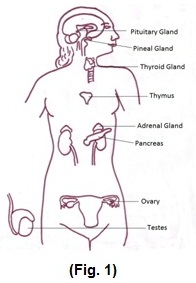Endocrine System
The endocrine system is a part of control system along with nervous system. Nervous system controls and co-ordinates the functions through electrochemical signals, a fast mechanism. As against this endocrine control over the metabolism is through chemicals named as hormones. Hypothalamus, which is a part of nervous system, can be regulated as a mediator between brain and endocrine system. (Fig.1)

The endocrine system consists of glands viz. pituitary, thyroid, parathyroid, thymus, adrenal, pancreas, ovaries (females), testes (males).
Few words on glands:
Basically, glands in our body are of 2 types:
- Exocrine glands
- Endocrine glands.
The exocrine glands secrete substances from their free surfaces For example sweat glands secreting on the skin, salivary glands are pouring their content in mouth etc.
Endocrine glands are ductless glands which release their secretions directly in to the blood stream e.g. Thyroid glands, adrenal glands etc.
Functioning of endocrine system
The endocrine system is a good example of feedback mechanism wherein the final product itself acts as a signal to enhance or inhibit the function of the concerned hormone.
Take an example of Adrenocorticotrophic hormone (ACTH). Stimuli in the form of pain, infection, hypoglycemia etc. are received by central nervous system (CNS) through different routes. The CNS sends impulses to hypothalamus to release corticotrophin realizing hormone (CRH). The anterior pituitary glands respond to CRH by releasing Adrenocorticotrophic hormone (ACTH). ACTH in turn, activates adrenal glands to secrete cortisol (final products). Cortisol exerts its action on muscles, liver, and adipose tissue. When enough quality of cortisol required for the activity is released, cortisol itself sends feedback signals to pituitary to inhibit the production.
How does cell receive message from the hormone?
A cell has a receptor to which the hormone binds and forms the hormone receptor complex. This hormone receptor complex activates further catalytic reactions resulting in amplification of the original signal leading to large amount of output of the desired substance e.g. one molecule of epinephrine causes production of many thousands molecules of glucose -1- phosphate from glycogen.
Endocrine glands in human system, their hormones anal organs/ tissues affected by their action :
| Glands | Hormones | Action | |
| 1. | Adrenal cortex | Cortisol, Corticosterone, Aldosterone | Many tissues |
| 2. | Thyroid | Triiodo- thyronine(t3), Thyroxin(t4) | Muscles, liver |
| 3. | Ovaries | Progesterone, Estradiol | Reproductive organs |
| 4. | Testes | Testosterone | Reproductive organs |
| 5. | Islets cells of pancreas | Insulin, Glucagon, Somatostatin | Liver, muscles |
| 6. | Adrenal medulla | Epinephrine | Liver, muscles, heart |
| 7. | Ant. Pituitary | Somatotropin (growth hormone) | Liver, bone |
| 8. | Ant. Pituitary | Prolactin | Mammary glands |
| 9. | Post pituitary | Oxytocin | Smooth muscles, Mammary glands |
| 10. | Post pituitary | Vasopressin | Arterioles, kidney |
The table above indicates that functioning of tissues and organs are affected not only by one hormone but may be with number of hormones e.g. Thyroid hormone affects the muscles and liver, so also the insulin hormone. However, thyroid hormone affects this tissue by increasing the metabolic activity of the cells while insulin will help these cells to take up excess glucose from the blood. The main function of endocrine system is to bring coordination into these actions and achieve equilibrium what is termed homeostasis.
